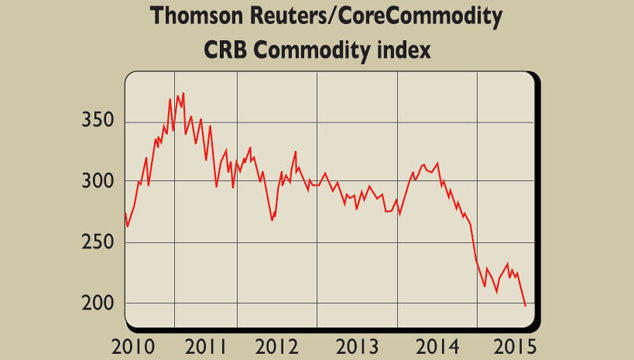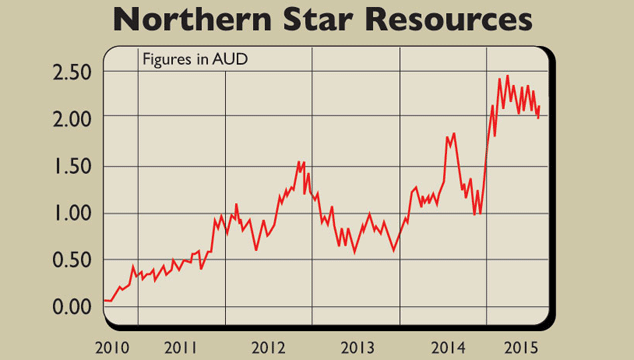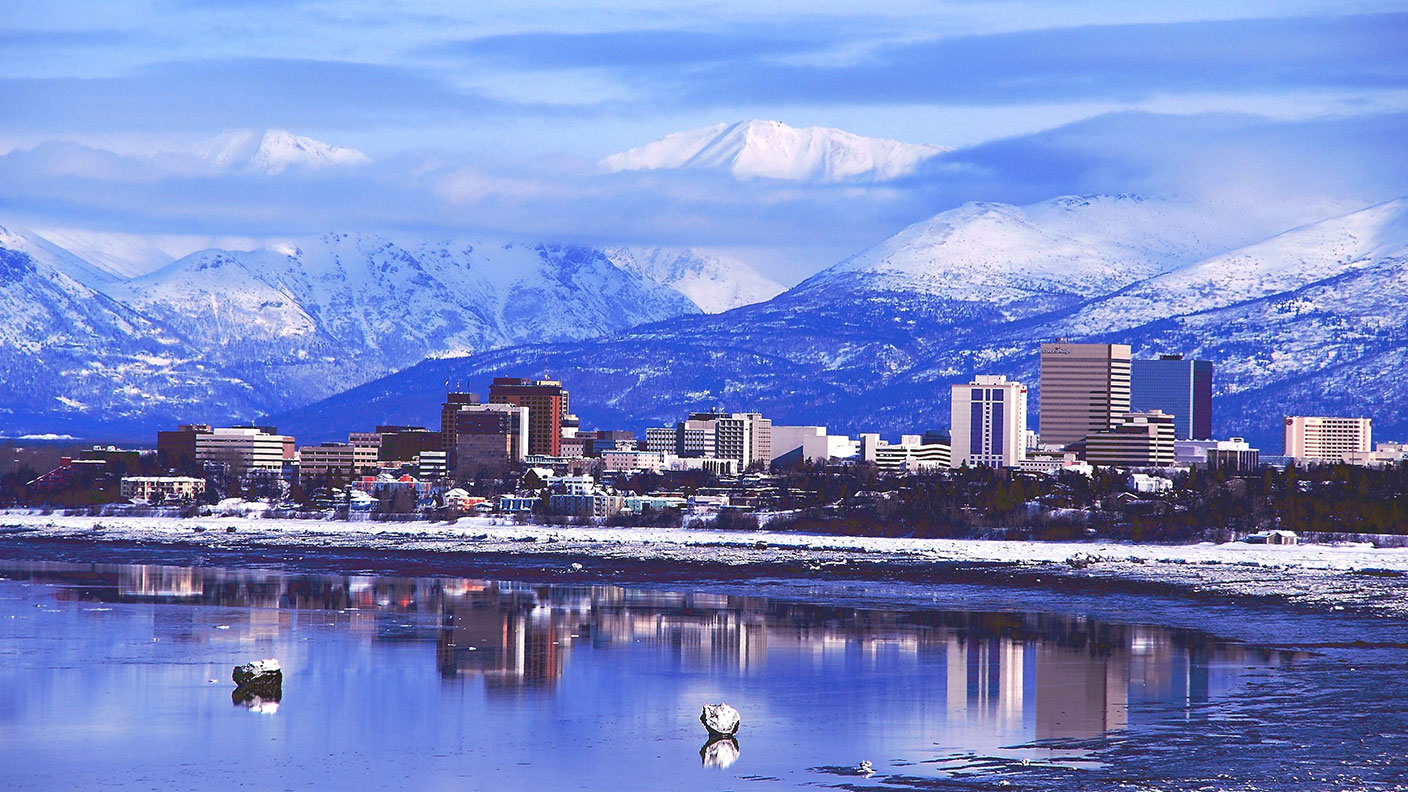How to profit from falling commodities prices
Commodities are plunging lower and that could be a signal everything else will follow. Alex Williams looks at how clever investors can still profit.

Commodities are plunging lower and that could be a signal everything else will follow, says Alex Williams.
An eye-popping gap is opening up in the global economy. For several years, stockmarkets have been booming around the world. In America the S&P 500 motored through an all-time high in February, while the FTSE 100 closed above 7,000 for the first time in March. Tokyo's Nikkei 225 index has more than doubled in three years, while Germany's Dax broke so many former records earlier this year that journalists stopped reporting each new high.
High-risk stocks, including banks, housebuilders and airlines, have been the winners. Shares in Michelmersh Brick, one of the UK's biggest brickmakers by revenue, have risen fourfold in four years. Lloyds Banking Group and International Consolidated Airlines, the holding company for British Airways, have more than tripled in the same period.
MoneyWeek
Subscribe to MoneyWeek today and get your first six magazine issues absolutely FREE

Sign up to Money Morning
Don't miss the latest investment and personal finances news, market analysis, plus money-saving tips with our free twice-daily newsletter
Don't miss the latest investment and personal finances news, market analysis, plus money-saving tips with our free twice-daily newsletter
The UK's largest housebuilder, Barratt Developments, has been another parabolic performer. An investment of £100,000 in Barratt four years ago would now be worth nearly £1m. It is a quintessential risk rally but with one key exception.
Usually, such a dramatic surge in high-risk stocks would be led by the most volatile sector of all: the mining industry. But not only have miners been eerily absent from the bull, they have declined consistently throughout. Glencore, a dominant player in coal, copper and zinc, listed in London in May 2011 at £5.30.
On Monday, the shares sank through a new all-time low, touching £1.99. Nearly $60bn has been wiped off the value of Anglo American over the same period, sending its shares below levels seen during the depths of the financial crisis. The losses are reflected across the whole sector, from other giants such as BHP Billiton and Rio Tinto to thousands of smaller firms.
The key turning point in the performance of commodities stocks was 2011. Until then, share prices were rising across the board. But ever since, markets have rocketed higher in an almost straight line, while mining companies diverged decisively and have chronically underperformed. The FTSE 350 mining index is down by two-thirds, repeatedly breaking through each new floor.
After four years of heavy losses, capped by an accelerating sell-off in recent weeks, mining assets now look disconcertingly inexpensive. Three years ago, Sumitomo, one of Japan's largest trading houses, paid A$430m for a 50% share in the Isaac Plains coal mine in Queensland. Last week, the mine changed hands for just one Australian dollar, equal to 73 US cents. "It's a nominal sum," said Nick Jorss of Brisbane-based Stanmore Coal, which bought the mine. "From our point of view, now is not a bad time to be out there looking for assets."
Cheaper than cabbage
There are even more glaring examples. In mainland China, steel is now cheaper than cabbage on a per tonne basis, while iron-ore miners are jumping out of the metal into everything from landfill to eggs. Perth-based Gindalbie Metals recently applied to convert its licence area in Western Australia into a dump for nuclear waste, while Century Iron, an explorer in snowy Quebec, told the market in July that under an agreement with Sunny Queen, a food giant in Australia, it will now primarily focus on selling eggs in Asia.
Century hailed the deal as "a historic debut of Sunny Queen's products in Hong Kong", but it is an outlandish sidestep in strategy and a clear sign of the market's distress. Even BHP Billiton, the world's largest diversified miner, is struggling to find market support. The company has increased its dividend every year since it was created in a mega-merger in 2001.
But after sliding more than 20% in the last three months, its shares are now yielding nearly 7%. For the first time in ten years, the mining industry offers investors a higher dividend yield than the FTSE 100, according to Bernstein analyst Paul Gait.
The cycle turns
But are mining shares cheap, or is the index expensive? Superficially, the mining industry has been alone on its depressing trajectory an anomaly against the wider market. This is widely attributed to a combination of the slowdown in China and the tendency of commodities to overshoot in cycles of boom and bust, thanks to a weakness for zealous overinvestment.
China's appetite for commodities soared during the last decade as the country embarked on an industrialisation and infrastructure boom. It now uses nearly 50% of the world's copper and two-thirds of its iron ore. But the country's growth rate slowed last year to an official estimate of 7.4%, down from consistent double-digit rates a few years ago. That slowdown is expected to continue along with a potential reduction in how resource-intensive China's GDP is as the country aims to move from a dependence on investment to a greater contribution by consumption and services.
Unfortunately, the mining industry has based many of its largest investment decisions on Chinese commodity demand continuing to grow at turbocharged rates. For example, since 2009 Rio Tinto has more than doubled iron-ore shipments from its vast operations in Australia's Pilbara region. Fortescue Metals, which trails itself as "The New Force in Iron Ore", has similarly cranked-up annual output volume from zero in 2008 to 165 million tonnes today.
Given similar increases by BHP and Brazil's iron giant Vale, it's no surprise the iron-ore price has buckled: prices for spot (immediate) delivery fell to less than US$45 per tonne earlier this month, down almost 40% this year and more than 75% since 2011.
But the explanation for the commodities rout goes deeper than ballooning supply, or slowing growth in China. If this were the whole story, why would copper prices be in free fall, when production growth in the metal has remained constrained? Instead, commodity prices are sending an important signal of the state of the global economy a signal backed up by a timely but overlooked indicator.
Global trade is slowing
Global trade volumes act as a hyper-sensitive indicator of economic activity. They plummeted by 12% in 2009 as a result of the global financial crisis. They then rallied strongly after the crisis, exactly like the mining industry, before petering out at the beginning of 2011. Since then, we have seen the longest period of lacklustre growth in global trade on record, according to figures published by the World Trade Organisation.
Country-by-country customs statistics all follow the same trend. Imports into the US and exports from China both rebounded strongly after 2009, but since 2011 volume growth has failed to find a steady footing. German exports have barely budged for the last four years.
Global trade figures for the first quarter of this year were startlingly soft, pointing to the sharpest global contraction since 2008. And more recent statistics published by the World Trade Monitor, a Hague-based data service funded by Holland's ministry of economics, say trade volumes have fallen in four of the last five months. So the mining industry is not alone in its relentless, downward grind.

Everywhere from FedEx deliveries in America to iron-ore imports into Rotterdam, the steel capital of Europe, telltale economic indicators are pointing to the same conclusion: physical demand from the global economy peaked in 2011 and has been contracting steadily since."Volumes are sluggish," Soren Skou of Danish shipping giant AP Moller-Maersk told reporters earlier this year. "There is nothing in container volume numbers that suggests that the global economy is just on the verge of starting a new growth trend."
One explanation for the slowdown in trade trotted out by the IMF is "on-shoring" or "de-globalisation": the idea that firms are increasingly consolidating their supply chains in one country, so that only the finished product shows up in customs figures. This is a convenient theory for policymakers, but it is difficult to explain the speed of the shift since 2011.
Instead, a simpler explanation for the combination of lacklustre trade and the rout in commodities is a deflating global economy. This may not seem consistent with other evidence, such as buoyant asset markets. But it appears that the global economy has cleaved into two, largely as a result of the measures adopted by policymakers since the global financial crisis.
Buoyed by unlimited government stimulus in every major economy from Japan and China to America and Europe, the paper economy is booming, led by banks, mortgages, housing and the stockmarket. Yet the mining industry has remained true to underlying demand in the physical economy. And now the unusually broad-based rout in commodities tells us that this is palpably slowing down.
So contrarians should not be tempted into mining stocks. They should be tempted out of the wider index. That said, a handful of mining companies are well-positioned to mop up assets as prices fall.
Below,I've profiled a few firms that investors should have on their watchlists.
The stocks to keep an eye on
A tiny minority of mining companies are benefiting as prices go down, using acquisitions to grow their underlying businesses at a low point in the cycle. Without exception, they are led by the industry's greatest contrarians, who tend to be low-key and unknown outside the world of mining, such as Canadian prospector Brian Dalton, or Australian gold mine contractor Bill Beament. They are disciplined, debt-free and keen for the mining markets to fall further, allowing them to snap up larger assets.
For example, Altius Minerals (Toronto: ALS) was founded by Canadian explorer Brian Dalton in Newfoundland in 1997 when he was still in his twenties. The company listed at the beginning of an abysmal bear market, but Dalton quickly struck on a new financing model: rather than issue shares to fund high-cost drilling, Altius began optioning out its properties to larger companies, including Rio Tinto and BHP Billiton, in exchange for cash, shares and a royalty on future production.
It was a major financing breakthrough. Now known as the "prospect generator" model, it means that small companies can turn over a huge number of properties by serially using joint-ventures, without risking their own cash on any one discovery.
In the last ten years, Altius has spent $16m on exploration, versus $220m collected in cash and share payments. Listed on the Toronto stock exchange, shares have risen more than 4,000% since Dalton founded the company. "Run properly," he says, "exploration can be a profitable business." Altius is using the current downturn to bolt on assets in coal, potash and copper that are already generating cash. Market conditions have got "even better", Dalton said after the company's latest acquisition. "By better, I mean worse."
Mining majors are reliably sucker-punched by the cycle, but some companies repeatedly put themselves on the other side of the trade. For example, BHP Billiton relinquished land adjoining its Saraji coal mine in Queensland in 2002, at the depths of a coal bear market. New Hope (Australia: NHC), which is based in Queensland and listed in Sydney, snapped up the ground for free, drilling out a 690 million tonne coal resource and securing port allocation.
Coal prices had meanwhile tripled and in 2008 BHP unblushingly bought back the asset for A$2.5bn ($2.4bn) in cash. New Hope paid out the windfall in dividends and has remained profitable against the odds in the current bear market. Backed by Washington H. Soul Pattinson, one of Australia's largest conglomerates, New Hope is again prowling for assets.
The gold mining industry used the last bull market to wrack up debt and build marginal projects, but Northern Star Resources (Australia: NST), a little-known operator of one gold mine in Western Australia, was too busy paying out dividends and building up cash. When prices tumbled in 2013, gold majors Barrick and Newmont retrenched to their core operations in the US, throwing their Australian assets on the block.

Reflecting how few companies had used the bull market to bolster their balance sheets, Northern Star's boss Bill Beament, a cost-cutting mine contractor, found himself the only bidder. "We sat on the sidelines, made sure we had a great balance sheet and the team in place and were ready to pounce."
In three major deals in 12 months, Beament swallowed five gold mines for less than A$200m, lifting the company's output sixfold. The collapse in coal and iron ore has, meanwhile, battered the Australian dollar, which has fallen close to a six-year low versus the US dollar, helping Beament to achieve margins of more than 30% even at current gold prices. While shares in Barrick and Newmont continue to be decimated, Northern Star has lifted its dividend and shares have more than doubled since December.
Backed by mining billionaire Robert Friedland, Vancouver-based Kaizen Discovery (Canada: KZD) was founded two years ago to mop up copper assets in the current mining malaise. Chief executive Matthew Hornor previously practised corporate law in Japan and enjoys close links to the country's metal-hungry trading houses.
Operating in Canada, Australia and Peru, Kaizen (which means "continuous improvement" in Japanese) has been buying-up copper projects within shipping distance of Japanese ports, using shares and financial backing from trading giant Itochu to swallow smaller companies at distressed valuations. "A lot of junior mining companies have been creamed, totally destroyed," Hornor says. "We're transacting and being active in a very inactive market."
Get the latest financial news, insights and expert analysis from our award-winning MoneyWeek team, to help you understand what really matters when it comes to your finances.
-
 High earners face £15k income hit by 2029 following Autumn Budget
High earners face £15k income hit by 2029 following Autumn BudgetRachel Reeves’s Autumn Budget means high earners – or HENRYs – are now looking at an income hit running into the thousands. Can you avoid it?
-
 Millions underestimate how many paydays are left until retirement - why you should be counting your payslips
Millions underestimate how many paydays are left until retirement - why you should be counting your payslipsKeeping track of how long you will be earning a salary for can help work out how much you need to put into a workplace pension
-
 Governments will sink in a world drowning in debt
Governments will sink in a world drowning in debtCover Story Rising interest rates and soaring inflation will leave many governments with unsustainable debts. Get set for a wave of sovereign defaults, says Jonathan Compton.
-
 Why Australia’s luck is set to run out
Why Australia’s luck is set to run outCover Story A low-quality election campaign in Australia has produced a government with no clear strategy. That’s bad news in an increasingly difficult geopolitical environment, says Philip Pilkington
-
 Why new technology is the future of the construction industry
Why new technology is the future of the construction industryCover Story The construction industry faces many challenges. New technologies from augmented reality and digitisation to exoskeletons and robotics can help solve them. Matthew Partridge reports.
-
 UBI which was once unthinkable is being rolled out around the world. What's going on?
UBI which was once unthinkable is being rolled out around the world. What's going on?Cover Story Universal basic income, the idea that everyone should be paid a liveable income by the state, no strings attached, was once for the birds. Now it seems it’s on the brink of being rolled out, says Stuart Watkins.
-
 Inflation is here to stay: it’s time to protect your portfolio
Inflation is here to stay: it’s time to protect your portfolioCover Story Unlike in 2008, widespread money printing and government spending are pushing up prices. Central banks can’t raise interest rates because the world can’t afford it, says John Stepek. Here’s what happens next
-
 Will Biden’s stimulus package fuel global inflation – and how can you protect your wealth?
Will Biden’s stimulus package fuel global inflation – and how can you protect your wealth?Cover Story Joe Biden’s latest stimulus package threatens to fuel inflation around the globe. What should investors do?
-
 What the race for the White House means for your money
What the race for the White House means for your moneyCover Story American voters are about to decide whether Donald Trump or Joe Biden will take the oath of office on 20 January. Matthew Partridge explains how various election scenarios could affect your portfolio.
-
 What’s worse: monopoly power or government intervention?
What’s worse: monopoly power or government intervention?Cover Story Politicians of all stripes increasingly agree with Karl Marx on one point – that monopolies are an inevitable consequence of free-market capitalism, and must be broken up. Are they right? Stuart Watkins isn’t so sure.